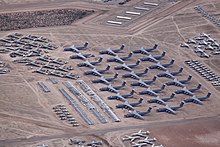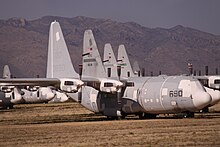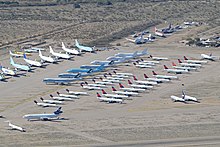Aircraft graveyard

Areas (mostly airfields) are designated as aircraft graveyards on which aircraft are either parked during temporary non-use or are cannibalized and recycled.
purpose
The military uses aircraft cemeteries, on the one hand, to maintain a certain " reserve " of old but airworthy machines, and on the other hand - in the event of disarmament or modernization - to utilize limited recycling capacities in the long term. Fluctuating prices (e.g. for aluminum ) also play a role here. Civil airlines sometimes shut down their planes temporarily (e.g. during the post-9/ 11 aviation crisis ); the term “cemetery” is then misleading. Parking at aircraft graveyards is many times cheaper than parking fees at regular airports.
conditions
Aircraft graveyards should meet the following requirements for effective storage:
- lots of space, which means cheap terrain
- Protection against theft and vandalism through spatial seclusion and simple security
- a hard, natural subsurface that allows aircraft to move without artificial surface sealing (e.g. asphalting)
- warm and dry climate to avoid corrosion and water damage
- a stable political environment (no risk of war or unrest).
These requirements are ideally met , for example, in the desert regions of the USA .
Infrastructure
The infrastructure results from the respective use (interim storage facility or scrapping site):
- Fencing and guarding
- Tractors (e.g. aircraft tugs, tractors)
- Devices for refueling and defueling
- Workshops or dismantling companies
- Land transport links.
activities
The activities at aircraft cemeteries include - in addition to pure storage and guarding - four areas:
Decommissioning
When decommissioning, measures for conservation and avoidance of environmental damage must be taken. Airlines are reluctant to publish the shutdown of machines, as this allows conclusions to be drawn about the company's current market situation. Therefore, the logos and lettering of parked machines are sometimes made unrecognizable. The windows are masked to prevent the seat covers from fading due to the sun's rays. The fuel tanks are emptied and auxiliary materials such as lubricating oil , hydraulic oil and batteries are removed. The machine may also be jacked up. Finally, all openings (including engines) are closed.
Measures against pests such as insects or rodents may also be taken.
Recommissioning
Failed maintenance and safety checks must be made up for, the measures taken for decommissioning must be reversed and, if necessary, further aging effects must be compensated:
- Refueling
- Equipping with auxiliary materials (hydraulic oil, water, batteries, etc.)
- Chassis check, inflation or change of tires if necessary
- Cleaning and removal of all seals
- Documented tests of all safety-relevant systems, if necessary exchange of "expired" components such as first aid kits
- If necessary, adaptation to a new owner (replacement of seats and galleys, painting, etc.)
Recovery
Usable components are removed and resold, raw materials are sorted and sent for recycling; in the case of airplanes, these are mainly large amounts of aluminum.
disposal
Components that are no longer usable are disposed of in accordance with local regulations - or the customer's environmental protection requirements.
Examples
The following list shows the majority of the largest aircraft graveyards.
- Bruntingthorpe Airfield , England
- Teruel Airport , Spain
- Phoenix Goodyear Airport , Arizona
- Kingman Airfield
- Pinal Airpark , Arizona; formerly Evergreen Maintenance Center (EMC)
- Mojave Airport , California
- Roswell (New Mexico) Airport
- Tucson: MASDC / AMARC Tucson, Arizona; former names: MASDC, AMARC
- Victorville , California Airport
Web links
Individual evidence
- ↑ Field Guide To Aircraft Boneyards , John A. Weeks (English); Retrieved June 2, 2015






